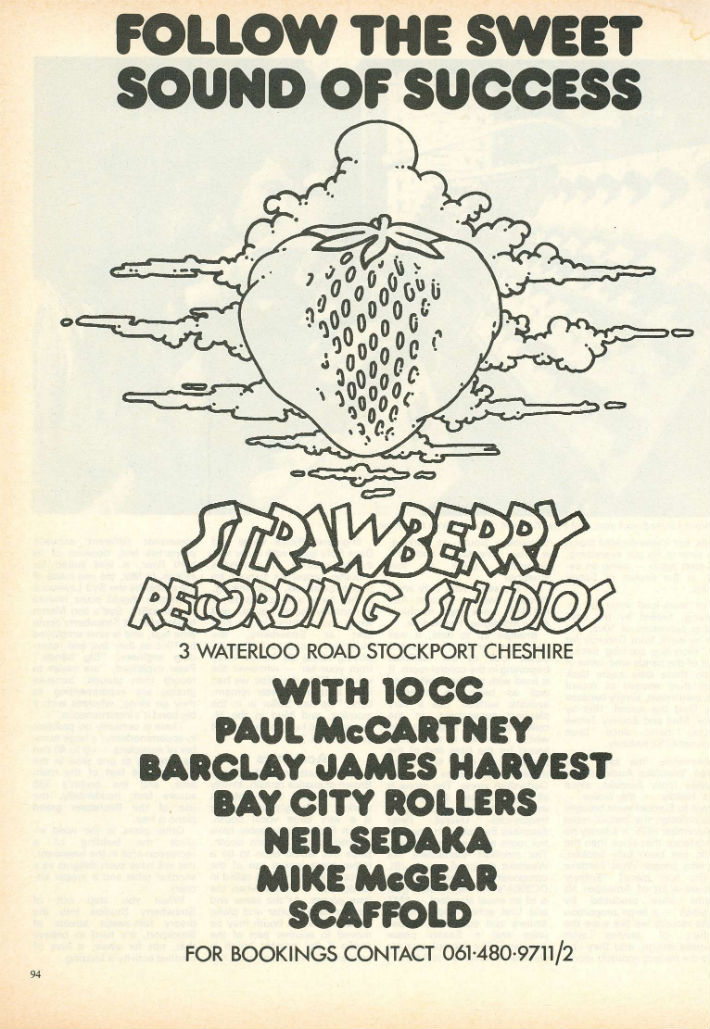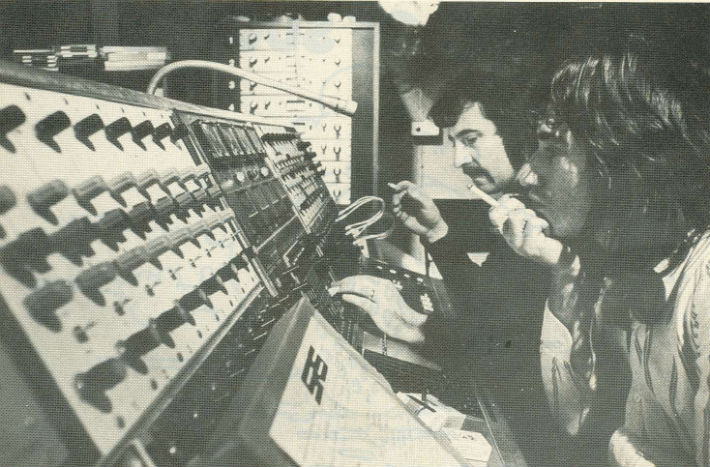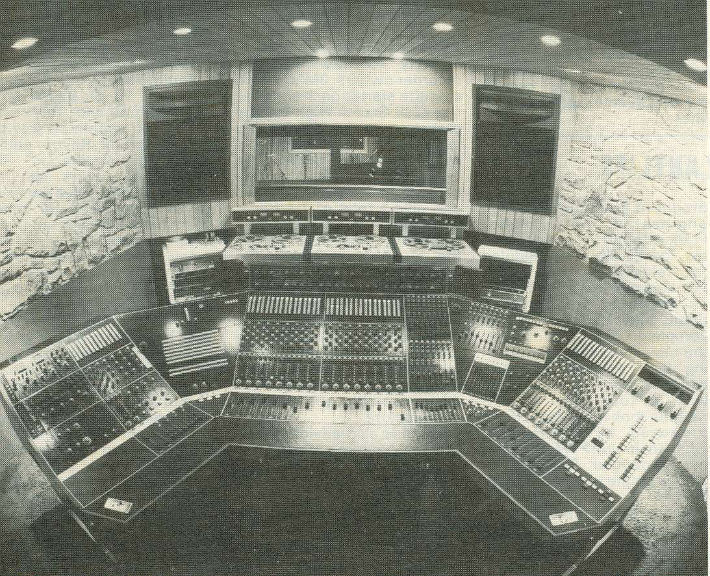A fascinating article, originally published in Beat Instrumental magazine in 1976, on the ground-breaking production processes and equipment at Stockport’s Strawberry Studios, spiritual home of 10cc and Paul McCartney among others, in the early to mid 1970s.

Since Beat last visited Strawberry Studios in April of last year there have been considerable changes, and, despite the fact that they have been open in one form or another for about nine years now, there are more to come. But first things first.
For those who still don’t know, the studio is located in Stockport, half-way up a hill called Waterloo Road. The first things you notice on stepping into the reception office – apart from Peter Tattersall sitting behind the desk – are two silver discs: Donna and Rubber Bullets by 10cc. And in fact the band and the premises are closely linked, because Eric Stewart and Graham Gouldman are Peter’s business partners. Peter prefaced his remarks by saying, “We’re very proud of our studio” and went on to outline its history after they had decided to make Strawberry something more than a demo studio.
“Back then we had a 16-channel, 4-track desk, which we built ourselves by roping in various guys; then there was an Ampex 4-track recorder and two very old stereo machines.” This, of course, was quite respectable in those days. “Yes, especially up here. We were very conscious of the fact that we had to buy new equipment, and one of the main reasons for that was servicing – all the companies were in London, and with new stuff we’d be less likely to need them.”

The chief difficulty then was to convince the recording industry that they were serious. The North (that mythical terrain somewhere above Luton) had at the time no more than two monophonic demo studios, and all Strawberry’s early work was with small local bands. But even then their ambitions were one step ahead. “We had to prove that we could make hit records. What we really wanted was 8-track – we wanted a respected studio, and Neanderthal Man did it.” This was the hit single by Hotlegs (who later became 10cc) and Peter reckons that it was the first hit record made outside London, and thus was perhaps the most important break in the London monopoly.
“People thought the band was American. Eric, Graham and I always liked American records – we’ve always had a very tight rhythm sound, and that’s possibly why people thought Hotlegs were American. Another thing that helped us all was that Eric and I weren’t trained as engineers by any organisation, so we definitely had to use our own ideas about recording. Neanderthal Man was done on 4-track, so we had to develop a method of recording that was quite unique.”
If you probe hard enough, Peter will admit that he was once a musician himself, playing venues like the Cavern at the same time as the Beatles, but in large bands – usually 8-pieces with a horn section. This experience must even then have impressed upon him the importance of a good mix. But back to the history: after the hit single, they were able to go 8-track and bought a Scully recorder, plus two stereo Ampex machines. The desk was improved with the aid of Dick Swettenham from Helios. When 10cc formed a few months later, Strawberry’s fortunes were assured. After just a year and a half they were in a position to rebuild the studio completely; in went a 16 track MCI machine and a brand new Helios desk. They also invested in Studer stereo machines and a Dolby noise reduction system. The acoustics of the place were completely redesigned.

Originally they had done it themselves, but it was decided that it was time to rip out everything, and start again – using an expert, in the person of Sandy Brown.
The work-load went on increasing, fuelled by the continuing successes of 10cc, and also by work from Granada for ITV, recording backing tracks. A lot of the bands who came in to do these later came back when they wanted to record their own music, simply because they liked the sound. Hits by Sailor, Mud and Barclay James Harvest have since been produced at Strawberry.
Meanwhile, the saga continued: Westlake Audio of Los Angeles (now Eastlake, since Tom Headly – the brains moved to Europe) were brought in to redesign the control room
in November 1975. It’s surely no coincidence that since then the studio has been fully booked. But why choose West/Eastlake in the first place? “Entirely because a lot of American hit albums were produced by Westlake – a large proportion of the records we like were the product of studios with Westlake design, and they can build the perfect acoustic room.

Strawberry South, at Dorking, is also Westlake, and the separation there is just amazing. At the same time they went 24-track, with a Studer A80 VU16/24 track tape machine, and a redesigned Helios desk.
Brought up to date, it was now time for Beat to have a closer look at the facilities, beginning in the control room. It is lined with tree-bark, which as well as being an excellent acoustic surface, has a very pleasing appearance. In the ceiling above the desk is a trap which provides a nice dead sound for the bass end of the spectrum; on either side of the monitors are areas of solid Derbyshire stone. The stone is all angled in such a way as to evenly disperse the higher frequencies. Overall, Peter describes the sound in the control room as ‘very presencey’. The monitors themselves are Westlake designed, using JBL components and Crown DC300A’s. All the ancilliary gear is of an equal standard – EMT and Urei echo, Audio Design limiters and equalizers, Kepex units and a Studer phase correlator. The microphones are Neumanns, Beyers and AKGs.
Engineers Richie Close and Dave Rohl agree with Peter that the importance of a room’s acoustic properties cannot be over-emphasised. Close-miking, in their view, is no substitute for a naturally good sound, and when you’re sitting in the hot-seat at Strawberry, the musicians sound as if they are playing about six inches away from your ear – whatever the volume. “The day after we had it all installed…” Peter remembers, “we had Sailor in in the morning, and Mud in the afternoon, and I was quite amazed at the sound.”
There’s no problem accommodating a large number of musicians – up to 40 can be fitted in at one time in the 1,280 square feet of the main area, and the booth’s 180 square feet. Incidentally, the use of the Bechstein grand piano is free.
In the studio itself the Sandy Brown acoustics remain, simply because they have always worked. In the right-hand corner is a very large vocal booth, which Peter will probably have converted into a drum booth, since this would seen to be a rather more logical use of the space; Eastlake will be called in to do this – if and when the time comes. At the same end are the bass, guitar and piano traps. The vocal booth may be moved to another part of the studio if the present booth is converted. The other side has somewhat different acoustic properties and, because of its hard floor, is well suited for strings. In fact, the use made of the studio by the Syd Lawrence Orchestra should point toward its versatility.
Syd’s son Martin began work at Strawberry some time ago, and is now employed by 10cc as their live and recording engineer. “Big bands,” Peter explained, “are easier to record than groups, because groups are experimenting as they go along, whereas with a big band it’s instantaneous.”
There is certainly no problem in accommodating a large number of musicians – up to 40 can be fitted in at one time in the 1280 square feet of the main area, and the booth’s 180 square feet. Incidentally, the use of the Bechstein grand piano is free. Other plans in the wind include the building of a recreation area in the basement; this will have such delights as a snooker table and a proper kitchen. When you step out of Strawberry Studios into the dreary rain-swept streets of Stockport, it’s hard to believe that, not far away, a hive of creative activity is buzzing.
Find out more about the amazing Strawberry Studios on the site where we lovingly pinched this article from: strawberrynorth.co.uk. A site, which, incidentally, lovingly pinched the article from Beat Instrumental –
from back in December 1976.
